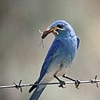Feeding Mealworms to Bluebirds:
If you have never seen or rarely see bluebirds around your yard, chances are that offering mealworms will result in your feeding the other birds who frequent your yard. If you already have bluebirds and want to ensure they stay, mealworms can be an effective enticement. In cold climates, small over-wintering songbirds like chickadees, nuthatches, etc. appreciate a small hanging cup of mealworms.
To discourage larger birds from eating your worms use a hopper style feeder. Mealworms can be placed inside the feeder with the bluebirds entering from a hole at either end. Bluebirds will readily explore this type of feeder and quickly recognize it as a food source. The 1 ½" hole at each end will effectively exclude larger birds. Smaller birds will soon catch on, but an aggressive male bluebird will usually defend "his" feeder, especially if he and his mate are nesting nearby. Place a flat saucer with a few worms in it on top of the hopper feeder to help draw the bluebird’s attention to the location of the feeder. Once they become familiar with the routine, the saucer should be removed and mealworms placed inside the feeder. Keep an eye on the feeder for the occasional bird who enters and then can't figure out where the exit is.
Offer mealy worms once or twice a day as a supplemental food source. A hundred or so worms offered morning and evening would be adequate for a pair of bluebirds with a box of nestlings.
Mealworms are not really worms at all but are the larval form of the darkling beetle (Tenebrio molitor). They are clean, easy to raise, do not carry human diseases and most importantly are a nutritious food supplement readily accepted by bluebirds.
Offer Mealworms to:
- Entice bluebirds to use a nest box
- Assist the incubating female to find food quickly so she does not have to leave her eggs for long periods of time
- Act as supplementary food for nestlings if food becomes scarce when weather conditions prevent the parents from finding insects
- Help them survive during spells of severe winter weather
MEALWORMS
Bluebird Suet Recipe
Recipe 1
Mix equal parts:
Chunky peanut butter
Crisco
Karo syrup
Melt in a pan over low heat. Let cool and stir in yellow cornmeal to a flaky consistency. Keep it in a tupperware container and feed it twice a day. For variety mix in some insects or mealworms.
FEEDING BLUEBIRDS

Bluebird Suet Recipe
Recipe 2
1 cup crunchy peanut butter
2 cups quick cook oats
2 1/2 cups cormeal (plain)
1 cup lard (do not substitute)
Optional: 1 cup wild bird seed, nuts raisins, dried fruit, insects, mealy worms
Melt lard and peanut butter. (Micro-wave works best.) Add remaining ingredients. Mix in large bowl, fill a wire cage and hang on a pole or crumble on platform feeder.
The best time to start feeding meal worms and suet is early spring. Bluebirds scout a territory looking for a desirable nesting area. Having a nest box and the availability of mealy worms may be the difference between attracting bluebirds to your yard or having them move on.

Care of Mealworms (Mealy Worms)
- Keep them refrigerated or in a cool place
- Avoid freezing them
- Remove from the refrigerator every 5-7 days, allow them to warm up and start moving around. Give them a few small apple cubes and leave them out for another hour or two.
- Refrigerate again. Remove the old apple cubes when you next take them out to feed and replace with new.
: Additional Resources :
: Sources for Mealworms :
Web Site Design by S&J Enterprises - Homestead Website Design
Tiny Bear Marketing Great products for birds and birding info

